Chmod Give All Permissions
Why Would Using Chmod 777 Recursively From The Root Cause A Linux Box To Not Boot I Could Understand This If I Were Limiting Permissions But Why Would Adding Permissions Cause This
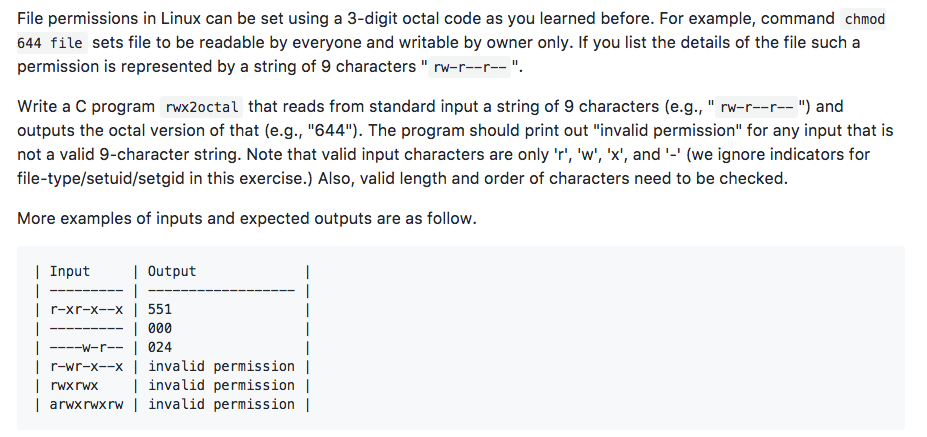
Solved File Permissions In Linux Can Be Set Using A 3 Dig Chegg Com

Linux Permissions Guide Plex Support
:max_bytes(150000):strip_icc()/i7guGwCYcn-34e068e148ae4e918b29c86cd2d5740e.png)
Configuring Unix Linux File And Directory Access Rights

Linux Permissions Guide Plex Support
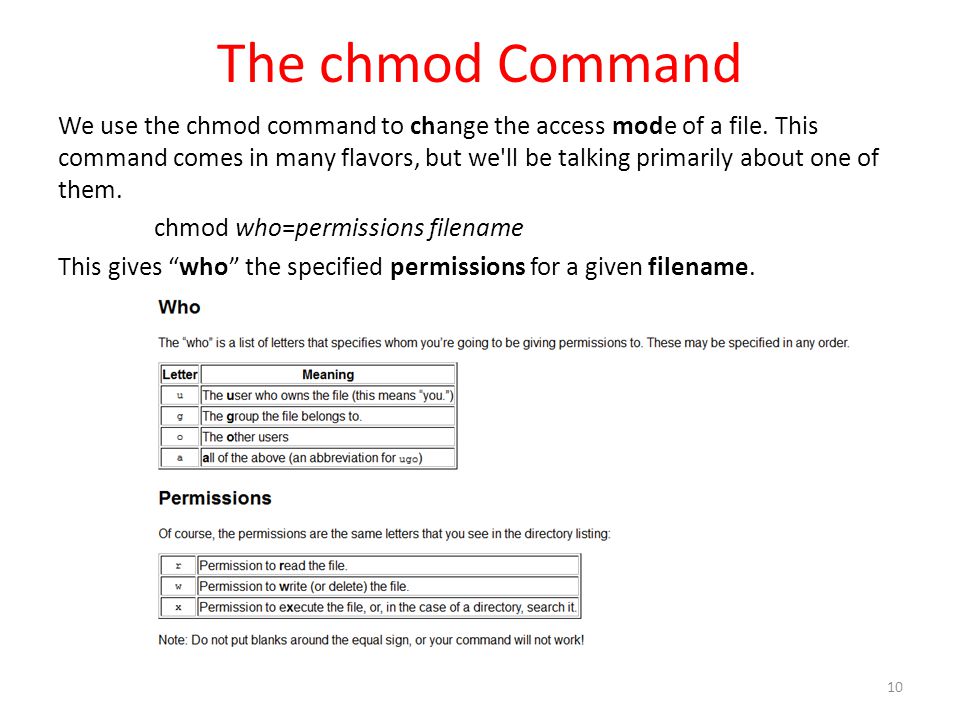
Workbook 4 File Ownerships And Permissions Ppt Video Online Download
The absolute mode functions like the exclusive permission of the symbolic mode in that it exclusively sets the permission specified removing all other.

Chmod give all permissions. For the Group, you need the same permissions, so they get the same number. So chmod 744 script.sh would give us the exact same permissions that we just observed on script.sh:-rwxr–r– Where the user has all permissions ( read, write, execute), and the group and other both only have read permissions. Meanwhile, since group and others are only allowed to read the file, we give them 4.
Add other options as desired;. We overwrite the current permissions). It can change file system modes of files and directories.
To give the owner all permissions and world execute you would type chmod 701 filename. The second way to modify permissions with the chmod command is to use a number to specify each set of permissions for the file. The second case, I will leave you guys to figure out.
Both the codes give read (code=4) permission to user, write and execute (code=3) for group and read and execute (code=5) for others. Every file and directory in your UNIX/Linux system has following 3 permissions defined for all the 3 owners discussed above. User - What the owner of the file can do.
So, if you want to give a file 664 permissions, you’d issue the chmod command like this:. For example, if you enter:. It stands for change mode.
How to Change Groups of Files and Directories in Linux. Recursive chmod using find, pipemill, and sudo To assign reasonably secure permissions to files and folders/directories, it's common to give files a permission of 644, and directories a 755 permission, since chmod -R assigns to both. Chmod -R will change all the permissions of each file and folder under a specified directory at once.
Linux file permission is a very important aspects in terms of security issues for the system administrator of Linux Operating System. We can restore chmod executable permissions using "setfacl" command. Chmod changes the permissions of each given file according to mode, where mode describes the permissions to modify.
To determine the mode (or permission settings) of a particular file, use the command `ls -lg filename'. Each shell script must have the execute permission. In Linux, who can do what to a file or directory is controlled through sets of permissions.
Other - What anyone else can do. As you can see, we start by first specifying the group permission group by utilizing the g letter. Using chmod 777 <file-name> gives everyone rwx permissions, and it is generally not a good practice to give full powers to all the users in a system.
This permission give you the authority to open and read a file. + for adding and – for removing. No such file or directory.
111 numerical value will grant execute permissions to user (owner), group and others to specified file. Therefore, rwx is equal to 7. The chmod command (change mode) is a shell command in Linux.
Accessing files in the Linux root file system from Linux Any files created, modified, or accessed in the Linux root file system follow standard Linux conventions, such as applying the umask to a newly created file. The all (a) mode is the same as ugo, allowing the previous command to be expressed as:. To make file readable, writable and executable by everyone.
This would grant all users and user groups with read and write access to your file, as well as allow all users to execute the file. I checked permissions and it's in root. Chmod 111 techtutorial Execute permissions to all.
The basic syntax is:. The permission scheme described above also applies to directories. Then, restore chmod permissions back to its original ones:.
To recursively operate on all files and directories under a given directory, use the chmod command with the -R, (--recursive) option. Mode can be specified with octal numbers or with letters. If you want to set permissions on all files to a+r, and all directories to a+x, and do that recursively through the complete subdirectory tree, use:.
There are three sets of permissions to worry about with any directory/file:. To remove the write permission for others for file2:. In each group, the first character is for read access ( r ), followed by write access ( w) and the right to execute ( x ).
I put in the random numbers/ letters assigned to it, but get error:. The chmod command changes the access permissions of files and folders. The modes include permissions and special modes.
Chmod ugo+rwx foldername to give read, write, and execute to everyone. View (u)ser, (g)roup and (o)thers permissions for chmod 766 (chmod a+rwx,g-x,o-x) or use free online chmod calculator to modify permissions easily. Server$ chmod go-rwx file.txt The file named script.cgi is now executable by the user and group.
With great power comes great responsibility, and there’s no denying that the chmod command is an extensive and powerful tool to change file permissions on Mac. It can be used for individual files or it can be run recursively with the -R option to change permissions for all of the subdirectories and files within a directory. Chmod is a command to change permission of a file.
One set for the owner of the file, another set for the members of the file’s group, and a final set for everyone else. To view the permissions for all files in a directory, use the lscommand with the -laoptions. CHMOD Calculator Chmod 644.
You only want Others to have read permissions, so they get 4. A Few Additional chmod Tips. Let us understand the Permission system on Linux.
And even this… chmod 775 file_name chmod ug+rwx,o=rx file_name Both the commands give all permissions (code=7) to user and group, read and execute (code=5) for others. The numerical equivalent is now:. First, modify ACL of a chmod binary file for user with read and execute permissions:.
As all Linux users, you will at some point need to modify the permission settings of a file/directory. Breaking this down, the a means all and rwx means set read, write, and execute. Read permission on a directory gives you the ability to lists its content.
Group - What users of the same group can do. Correspondingly, users have a username (unique to each user). By - Linux tutorial - team.
User, group or all. For our example command, we are going to give the group permission group, read and write privileges on a file called readandwrite. Chmod -R u+w,go-w docs:.
Using letters is easier to understand for most people. Mode can be either a symbolic representation of changes to make, or an octal number representing the bit pattern for the new. For help, see List the files in a directory in Unix.
# Permission rwx Binary;. Each permission is assigned a value, as the following table shows, and the total of each set of permissions provides a number for that set. For example, if you want the owner to have all the permissions and no permissions for the group and public, you need to set the permission 700 in absolute mode:.
Here are some examples of how to use the chmod command in numeric mode:. In Linux, files and directories are treated similarly. In the following example, g is group bit, o is the 'other users' bit and the -sign is removing all permissions (rwx):.
Changing permissions with chmod. Here are the other combinations you can have:. We’ll wrap up with a bit of extra advice related to chmod:.
The other way is terminal , where you can change the permission via Chmod. Read, write and execute:. A dash means that the permission is turned off.
Recursively) for owner, and removes write permission for group and others chmod ug=rw groupAgreements.txt:. The default umask is 022, or in other words it allows all permissions except write permissions to groups and others. The general syntax to recursively change the file’s permissions is as follows:.
Therefore, full permissions for everyone on the system would look like:. For a directory, whoever has `read'. Chmod +x filename.sh to make filename.sh executable.
To change directory permissions for everyone, use “u” for users, “g” for group, “o” for others, and “ugo” or “a” (for all). Permissions defines the permissions for the owner of the file (the "user"), members of the group who owns the file (the "group"), and anyone else ("others"). Chmod 775 /path/to/file chmod command uses & Explanation.
The chmod command allows you to change the permissions of files using symbolic or numeric mode. Avoid using boundary cases, such as chmod 777 <file-name> and chmod 000 <filename>. Chmod 700 filename You can do the same in symbolic mode.
A = all + = add permissions - = remove permissions r = read w = write x = execute t = sticky bit so to add read permissiones for people in the files group I would do chmod g+r file. Remember that you need read permissions in order to list directories and subdirectories. Chmod is command which changes permission of a file or folder for particular user or group as per instructions provided.
So if you want to give all permissions (rwx) to a user, we need to add read (4), write (2), and execute (1). If you provide same permissions to directory you can enter into directory but you can’t do anything, directory execute permissions means providing the access to enter into directory. If no options are specified, chmod modifies the permissions of the file specified by file name to the permissions specified by permissions.
Chmod Modifies File Permissions. View (u)ser, (g)roup and (o)thers permissions for chmod 644 (chmod a+rwx,u-x,g-wx,o-wx) or use free online chmod calculator to modify permissions easily. # chmod +x $(which chmod) Finally, remove all ACL entries of chmod.
Give the file’s owner read and write permissions and only read permissions to group members and all other users:. By setting permissions, you are replacing all existing permissions with the ones specified. If you need to list a file's permissions, use the ls command.
For example, to use chmod to set permissions of file "filename" to -rwxrwxrwx you could run:. After user level we have provide what needs to be done i.e. That’s why we enter 744.
Use sudo, the find command, and a pipemill to chmod as in the following examples. Chmod -R a+rX * click below button to copy the code. # setfacl -m u::rx /usr/bin/chmod.
To modify the permission flags on existing files and directories, use the chmod command ("change mode"). How to Set File Permissions Using `chmod' Files. Chmod -R MODE DIRECTORY.
I'm hoping if I change the permissions to non-root, it will let me add files. For example, to explicitly make file3 readable and executable to everyone:. Sets read and write permissions for user and Group, and provides read.
I think that is it, there might be some other options as well, consult the man page. If you use chmod 777 that means you assigned all the permissions i.e. Chmod command is followed by which level user i.e.
$ chmod 777 -R /path/to/Dir To assign reasonably secure permissions to files and folders/directories, it's common to give files a permission of 644 , and directories a 755 permission, using the find command and a pipe we can target just files. Adds write permission to the directory docs and all its contents (i.e. Give the file’s owner read, write and execute permissions, read and execute permissions to group members.
To give the owner all permissions and world read and execute you would type chmod 705 filename. Mykyta Dolmatov / Getty Images. Using chmod with Absolute Permissions.
My sd card in my usb card reader will not allow me to add files while in ext4. The permissions control the actions that can be performed on the file or directory. The chmod command specifies which class or classes (user, group, other) have access to the.
You can combine multiple references and modes to set the desired access all at once. Using symbols (alphanumerical characters) using the octal notation method. The chmod command, like other commands, can be executed from the command line or through a script file.
Chmod a=r foldername to give only read permission for everyone. Sets read and write permissions for user and Group:. There are three sets of permissions.
The command that executes such tasks is the chmod command. The = means that permissions are to be set to exactly what we specify.(i.e. Linux File Permission :.
Actually, chmod Command in Linux plays a greater role to keep all the files and directories of the system safe and secure so that no unauthorized person. Remember, the owner’s permissions always come first, then followed by group and others. Chmod permission file_name There are two ways to define permission:.
To give the User group read and write permission, you would add up 4+2 to get 6.
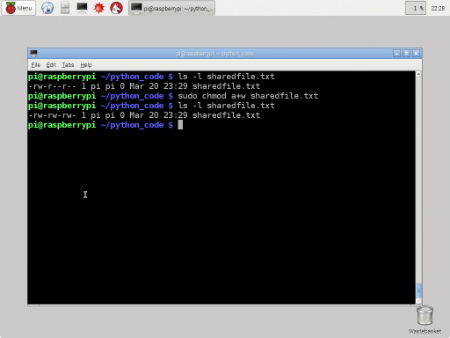
Working With File Permissions On Your Raspberry Pi Dummies

How To Change Permissions Chmod Of A File Hostgator Support

How To Change File Permissions Recursively With Chmod In Linux

Linux Permissions Guide Plex Support

Chmod 777 755 655 644 And More Permissions Linux Files Tutorials

8 Linux Chmod Command Examples To Understand It The Linux Juggernaut

Linux File Permissions Tutorial For Beginners
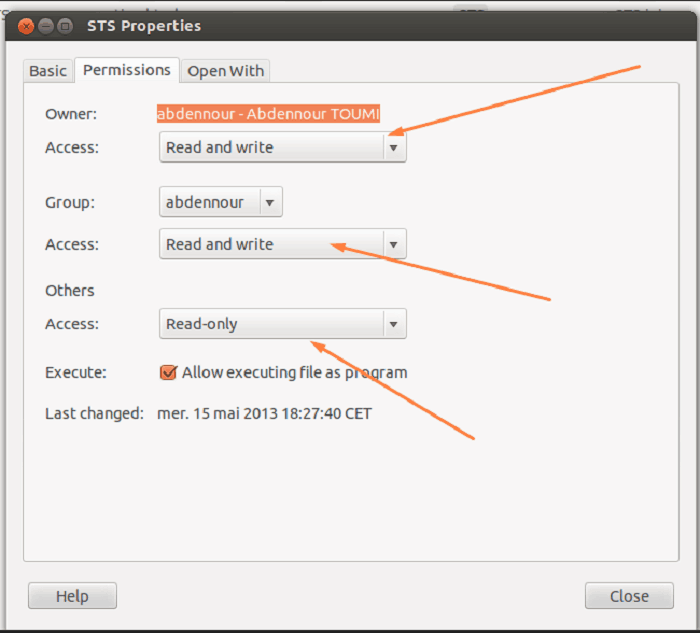
What Is Chmod 777 How To Change File Permissions For Linux Tech Ninja Pro

Chmod Command In Linux With Examples Geeksforgeeks

How Do Linux File Permissions Work

Chmod Wiki Ask Ubuntu

Linux File Permissions Tutorial How To View And Change Permission
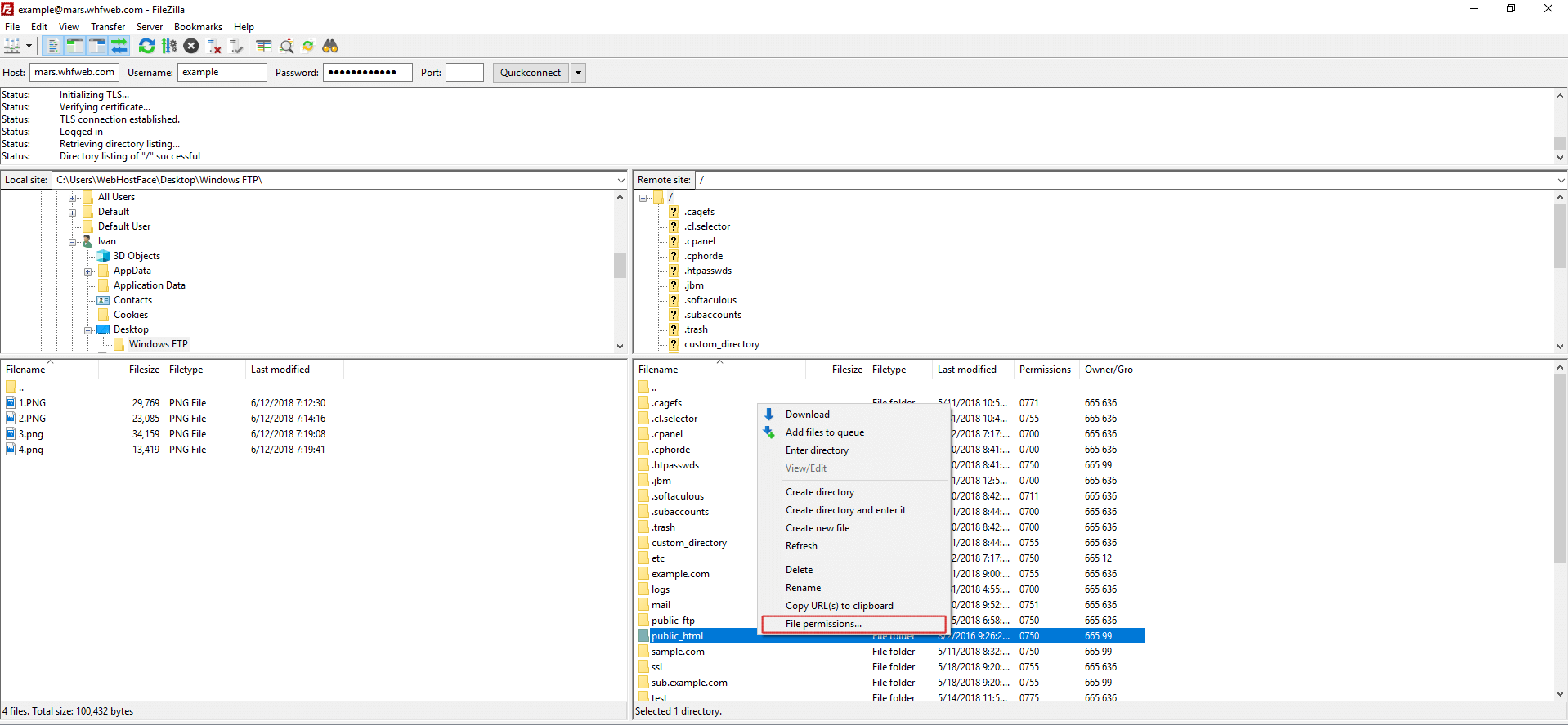
Change Ftp Permissions With Filezilla On Windows Computer

Chmod Command In Unix Unix File Permissions Chmod With Examples Chwn Command Chgrp Command Unmask

Use Of Chmod Command In Linux Devopsdex

How To Use Chmod Command In Linux Explained With Examples

What Is Chmod 777 How To Change File Permissions For Linux Tech Ninja Pro

Introduction To Linux File Permissions Attributes Chmod Globo Tech

User And Group Permissions With Chmod And Apache

Solved Chmod Can Be Used To Change The Mode Of The File Chegg Com

Directory How Can I Change Permissions Of A Folder Including Its Enclosed Files And Subdirectories Ask Ubuntu

File Permissions Rhel 7 Tutorial
Q Tbn 3aand9gcq2oq90gyu7qjtwwppsiodhgqotjbz3awrstnhczkm6hwgdiahx Usqp Cau
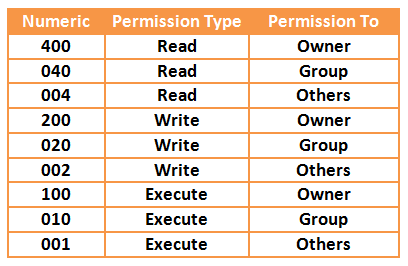
Your Own Linux Chmod Basics Of Files Directories Permissions And Use Of Chmod

Chmod Archives Yet Another Linux Blog

Linux File Permissions Complete Guide Devconnected

How To Use The Chmod Command On Linux
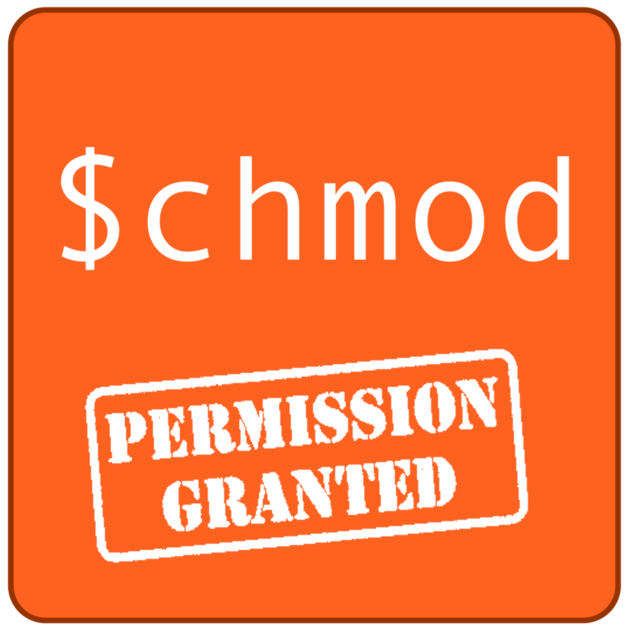
Changing File Permissions In Linux The Chmod Command By Saswat Subhajyoti Mallick Medium

Understanding File Permissions

Setting File And Directory Permissions Computational And Information Systems Laboratory

Setup Correct Files And Folders Access Permissions Efficiently Web Site Scripts Com

Understanding Basic File Permissions And Ownership In Linux The Geek Diary

Use Of Chmod Command In Linux Devopsdex

Change File And Folder Permission On Ubuntu Chmod Chown Command In Linux Youtube

Ownership And Permissions
.png)
File Permissions In Linux Unix With Example

Linux File Permissions Complete Guide Devconnected

Use Of Chmod Command In Linux Devopsdex

How To Deny File Permissions To Everyone Except Yourself In Linux Linuxhostsupport

Linux Terminal File Permissions Chmod Chown And Chgrp Youtube
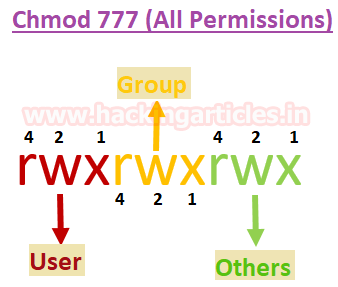
Linux Privilege Escalation Using Suid Binaries

How To Give Read Write Permissions To A Folder In Ubuntu Code Example

How To Set File Permissions In Mac Os X Macinstruct

Permissions In Linux Geeksforgeeks
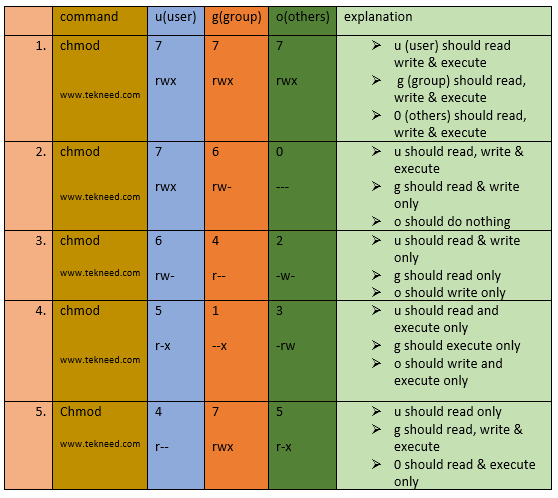
How To Set And Manage File Permission In Linux Part 1
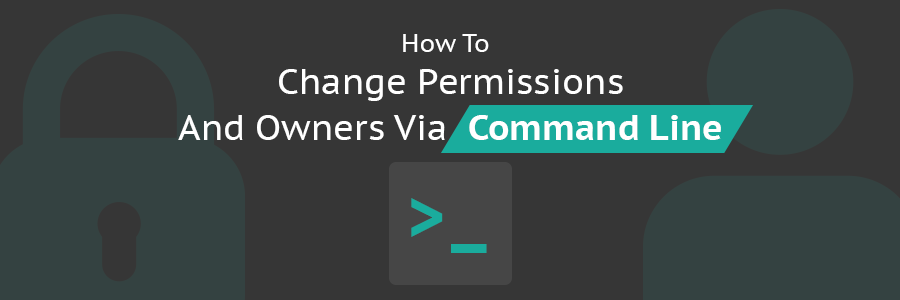
How To Change Permissions And Owners Via Linux Command Line

Linux Permissions An Introduction To Chmod Enable Sysadmin

Understanding Linux Permissions And Chmod Usage
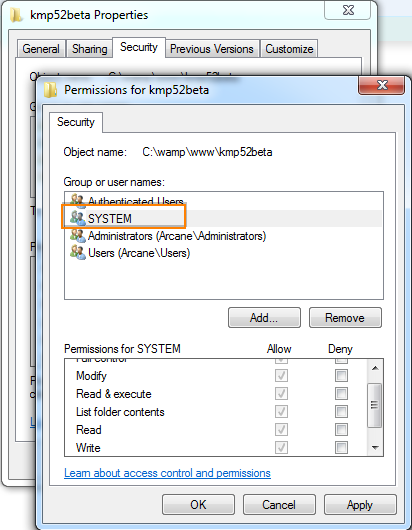
Setup Correct Files And Folders Access Permissions Efficiently Web Site Scripts Com
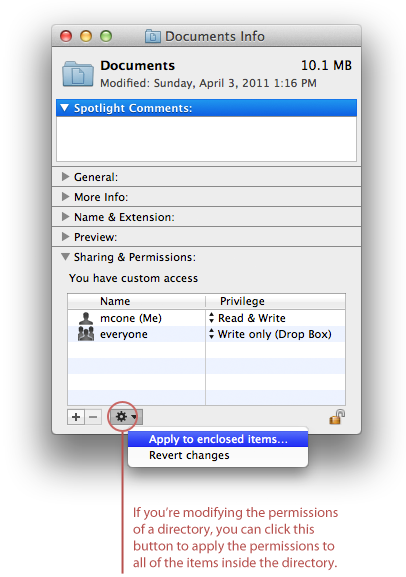
How To Set File Permissions In Mac Os X Macinstruct

How To Copy File Permissions And Ownership To Another File In Linux

Linux Chmod Example Linux Hint
Q Tbn 3aand9gcs J72hjomdluhqe6xjivy M6yrjmkqx9x3z3ps Rpnb8by3w7z Usqp Cau

Linux Commands 5 File Permission Chmod Youtube

Linux Chmod Command Tutorial With Examples To Change Permission Of Files And Folders Poftut

How To Use The Chmod Command On Linux

Chmod Wikipedia

Chmod 777 What Does This Mean Learn Linux Permissions Easy Way

Chmod Recursive Change Permissions Recursively On Files Folders

Changing File Permissions Wordpress Org

Give Write Access Chmod 775
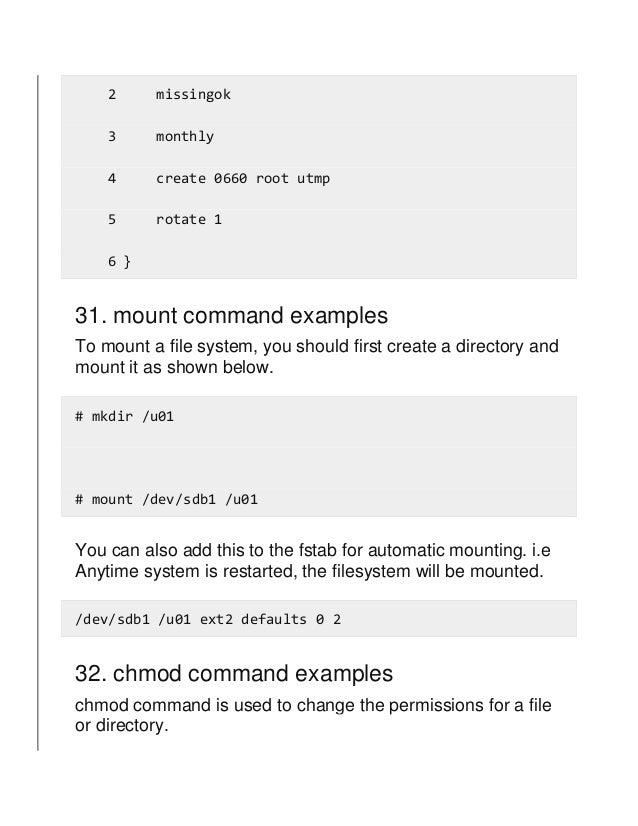
Give Write Access Chmod Unix

How To Use Chmod And Chown Command In Linux

How To Change Directory Permissions In Linux Pluralsight
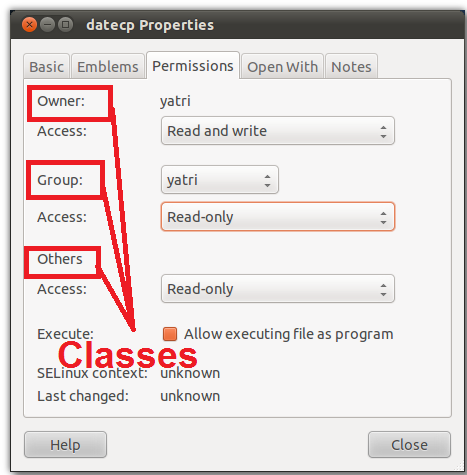
What Is Chmod 777

How To Use Chmod And Chown Command Nixcraft

An Introduction To Linux File Permissions Boolean World

Your Own Linux Chmod Basics Of Files Directories Permissions And Use Of Chmod

Give Write Access Chmod Command

Linux Unix Permissions And Attributes Linuxsecrets

How To Change Directory Permissions In Linux Pluralsight
Q Tbn 3aand9gcslbhvh5emm 4 Trrp3thfcmqosdrfzef Gvyldtqf1wtkgi37f Usqp Cau

Chmod Why It Matters User Permissions In Os X Droppedframe Com

How To Use The Chmod Command On Linux
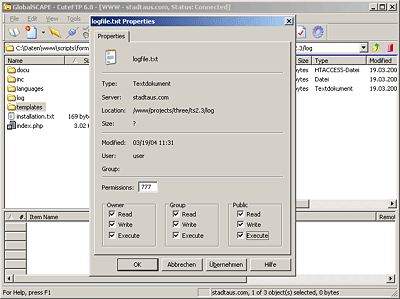
Chmod Ftp File Permissions Stadtaus Com
%20access%20permission%20%EC%98%88)%20chmod%20644%20test.jpg)
Permissions Why Use Chmod Instead Of Chmod U Rw Go R Unix Linux Stack Exchange

Permissions In Linux Geeksforgeeks

How To Use The Chmod Command On Linux Basic Linux Permission Linux File Permission Wiz Maverick Benisnous
Chmod Cheatsheet Linux
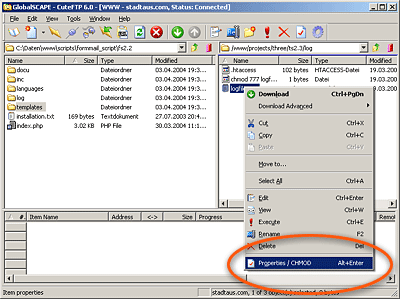
Chmod Ftp File Permissions Stadtaus Com

Learning The Shell Lesson 9 Permissions

Give Write Access Chmod 644
Q Tbn 3aand9gcr9rnnth31jdnr94db Zmbdt5bh907clokeeor9me5yqbuufaiw Usqp Cau

How To Modify The File S And Directories Permission In Linux Vasanth Blog

Chmod 0400 Means

Chmod 777 755 655 644 And More Permissions Linux Files Tutorials

Understanding Linux File Permissions With Chmod Umask Chown And Chgrp Liquidon Net

Modify File Permissions With Chmod Linode
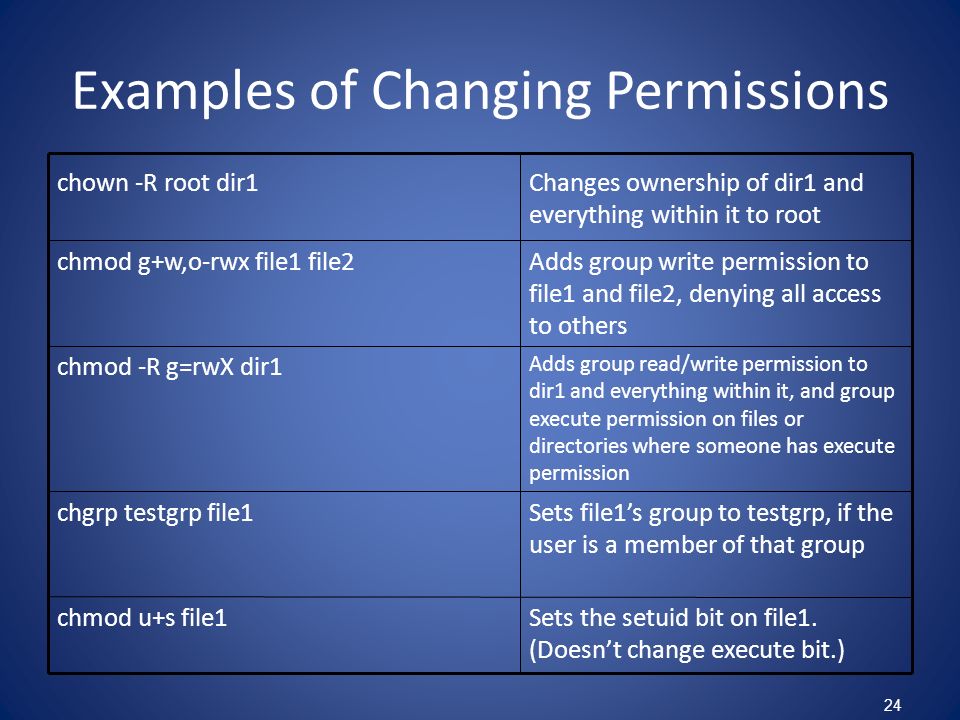
Permissions Why Use Chmod Instead Of Chmod U Rw Go R Unix Linux Stack Exchange

How To Change Directory Permissions In Linux Pluralsight

Chmod 777 What Does It Really Mean Make Tech Easier
Linux Chmod Tips

Linux Chmod Chown Syntax And Chmod Chown Examples

Linux File Permissions Know The Reason Behind That Chmod 777 By Abhishek Chandra Medium

Chmod 777 In Terminal The Command To Make All Changes Affect Every File And Folder Ask Ubuntu

Csc128 Permissions And Links Chmod And Ls
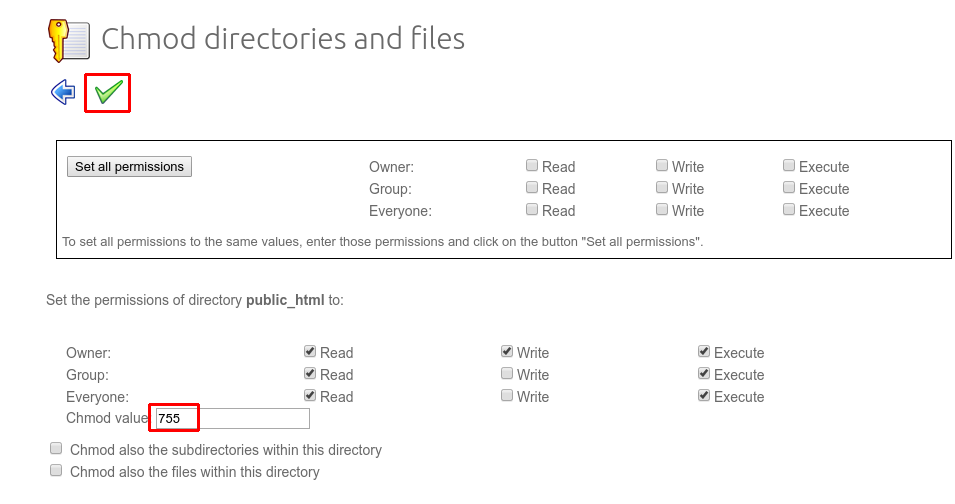
How To Set Access Rights For Files And Folders With Chmod

How To Change File Permissions Recursively With Chmod In Linux



